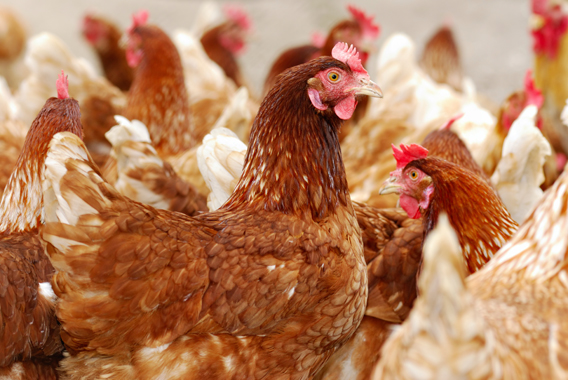Attacking Avian Flu
Tufts researchers in Indonesia lead the way training community surveillance and response teams to the potential pandemic
By Mark Sullivan
Some villagers call it “plok” for the sound of a dead chicken falling from its perch. Avian influenza, or bird flu, in Indonesia has led to the deaths of millions of birds, stricken by the virus itself or killed to prevent it spreading. This has been a blow to livelihoods in a nation where 60 percent of households keep chickens, ducks or geese.

“The only way to control the epidemic is through education, so that people understand the importance of controlling it at the local level,” says George Saperstein, the Amelia Peabody Professor and chair of environmental and population health at the Cummings School. Photo: iStockphoto
Ominously, the virus has spread to people. The 110th human death from bird flu recently was recorded in Indonesia, the site of nearly half of the worldwide human fatalities since the virus emerged in Southeast Asia in 2003.
Scientists fear the “H5N1” strain of the virus could turn into a form readily transmitted by humans, potentially causing a pandemic threatening millions of lives. This potential threat has resulted in an international effort that is under way to stop the disease at its source.
Tufts researchers have been working with the United Nations’ Food and Agriculture Organization (FAO) to train Indonesian villagers to detect and respond to outbreaks of avian flu in areas of the country where there is no organized veterinary care.
A $206,600 grant from the Rockefeller Foundation will help in studying the relationship between veterinary public health education and effective surveillance and response to infectious disease outbreaks in Indonesia. The long-term goal of the work is to improve veterinary public health capacity, including participatory epidemiology, in ways that will enhance animal and human health.
“Prevention is the key word here,” says lead investigator Joann Lindenmayer, V85, associate professor of environmental and population health at the Cummings School of Veterinary Medicine.
“To prevent an epidemic of avian flu from becoming a pandemic from person to person, we need early detection and intervention. You can’t have good human health without good animal health,” Lindenmayer says. “We’re all dependent on each other.”
“The only way to control the epidemic is through education, so that people understand the importance of controlling it at the local level,” says George Saperstein, the Amelia Peabody Professor and chair of environmental and population health at the Cummings School. “What’s different about this epizootic, or animal epidemic, is that it could kill the people themselves.”
Indonesia’s 220 million people are spread over 3,000 islands. Very few veterinarians in Indonesia are trained in epidemiology. With little or no veterinary public health infrastructure, teaching local people to recognize and respond to signs of the virus is key.
Ten Tufts researchers, nine of them veterinarians, currently are engaged full time in Indonesia training community surveillance and response teams. Six hundred of these teams are spread throughout the country to spot and respond to avian flu.
Is this sort of educational outreach model effective? Saperstein says the Rockefeller Foundation grant, which enables a 12-month study of their hypothesis that enhanced veterinary education at the local level, has a significant impact on disease prevention and control.
“We’re going to look at whether education indeed makes a difference, and whether it is possible to modify the educational process in the country to improve animal and human health,” Saperstein says. “We hope what we learn will be applied to the infrastructure in Indonesia, to help in early response to animal disease that could have a major impact on animal and human health.”
The goal is to establish a model to guide response elsewhere in Asia whenever an animal epidemic strikes. “If it can be done in Indonesia,” Lindenmayer says, “probably it can be done anywhere.”
“The project in Indonesia has taught us many things about how to mobilize communities against an infectious disease outbreak, and these lessons can be applied to controlling zoonotic diseases around the world,” says Deborah T. Kochevar, dean and the Henry and Lois Foster Professor at the Cummings School. Zoonotic diseases are those transmitted from animals to humans.
Saperstein maintains that, while veterinarians play a large role in public health, their participation is often overlooked.
Others agree. “We see a divide between the fields of veterinary health and human health, leading to poor communication and inefficient use of resources to detect and respond to outbreaks,” says Tara Acharya, an associate director at the Rockefeller Foundation.
“Animals are the likely source of 75 percent of the world’s emerging infections. In the event of a zoonotic disease outbreak, the world’s poorest people, who largely depend on animals for their livelihoods, are hit the hardest, with threats of disease, malnutrition and economic destitution,” Acharya says.
This story first appeared in the Spring 2008 issue of Tufts Veterinary Medicine magazine. Mark Sullivan may be reached at mark.sullivan@tufts.edu.


